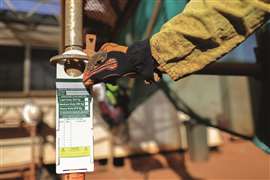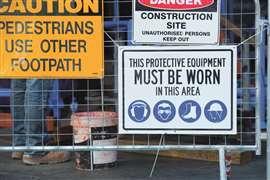Is OSHA ‘organized’?
16 September 2024
The U.S. Occupational Safety and Health Administration, OSHA, was created when U.S. President Richard Nixon signed the Occupational Safety & Health Act on December 29, 1970. The act required, amongst other things, that employers provide a safe workplace for employees.
 There are different scaffold regulations in both the maritime industry and in the construction industry. (Photo: Adobe – Kings Access)
There are different scaffold regulations in both the maritime industry and in the construction industry. (Photo: Adobe – Kings Access)
To assist employers in determining what constitutes a safe workplace, OSHA promulgated regulations that define a safe workplace. And, knowing that employers may not want to fully cooperate with OSHA, the act includes an enforcement element whereby failure to comply can be quite detrimental, including fines and in some cases, jail time.
Less known is that the act also requires that employees “Shall comply with occupational safety and health standards and all rules, regulations, and orders issued pursuant to this act which are applicable to his/her own actions and conduct.” Unfortunately, rare is the employee who knows this requirement exists. Fortunately, even rarer is any employee being cited for a violation of this obligation.
Understanding how to navigate nomenclature
It’s no surprise that employees, and employers too, can be easily intimidated by the OSHA regulations. Frankly, reading the OSHA regulations can be a daunting task since a first look at the OSHA regulations can be a frightening experience, particularly when you consider there are literally thousands of regulations.
Fortunately, once it is understood that the regulations are organized in a logical manner, what was once insurmountable, now seems attainable. While it might be difficult to accept, the OSHA regulations are actually arranged in a predictable fashion, making it easier for everyone, including employers, employees, and OSHA compliance officers, to find a specific regulation. Here is how it all works.
Breaking down the OSHA departments
First, OSHA has regulations for the general, construction and maritime industries. This is important to know since each industry has its own regulations which means that there may be regulations that address a specific hazard in multiple industries. For example, there are scaffold regulations in both the maritime industry and in the construction industry. Fortunately, each industry uses the same numbering system.
Next, to facilitate locating specific regulations, OSHA developed a numbering system that is used for all the regulations. To illustrate how the system works, let’s use the Construction Industry scaffolding regulations, which are designated 29 CFR 1926 Subpart L – Scaffolds.
The 29 is Title 29 and is assigned to the Department of Labor (DOL). In other words, all the DOL regulations are in Title 29, including the OSHA regulations since it is an agency within the DOL. CFR stands for Code of Federal Regulations. 1926 is known as a “Part” that identifies the Construction Industry regulations and each Part is divided into “Subparts,” which are lettered. In the Construction Industry regulations there are 28 Subparts, and in this example, the scaffold regulations are found in Subpart L.
 There are thousands of OSHA regulations and standards, according to Glabe, which makes finding the right information difficult at times. (Photo: Adobe – roboriginal)
There are thousands of OSHA regulations and standards, according to Glabe, which makes finding the right information difficult at times. (Photo: Adobe – roboriginal)
Numbers (and names) game
So far, we have arrived at the subpart that includes all the scaffold regulations. The next step is to understand how the Subpart numbering system works to get to a specific regulation. The Subpart uses a hierarchy of sections, paragraphs, letters, numbers and Roman numerals to identify a particular regulation. The hierarchy starts with the Sections, followed by paragraphs, followed by sub-divisions and, believe it or not, this is where the actual regulation is hiding.
There are five sections within Subpart L where you will find the actual regulations that address hazards found in the erecting, dismantling, alteration and use of scaffolds. These five sections are:
- 29 CFR 1926.450 - Scope, application, and definitions applicable to this subpart
- 29 CFR 1926.451 - General requirements
- 29 CFR 1926.452 - Additional requirements applicable to specific types of scaffolds
- 29 CFR 1926.453 - Aerial lifts
- 29 CFR 1926.454 - Training requirements
There are also five appendices:
- Subpart L, Appendix A - Scaffold specifications
- Subpart L, Appendix B - Criteria for determining the feasibility of providing safe access and fall protection for scaffold directors and dismantlers
- Subpart L, Appendix C - List of national consensus standards
- Subpart L, Appendix D - List of training topics for scaffold erectors and dismantlers
- Subpart L, Appendix E - Drawings and Illustrations
While you now are probably totally confused, perhaps an example will clarify how it all works.
OSHA’s hierarchy
Let’s use the regulation that specifies the size of a landing for a scaffold stairway used on a construction project to access a scaffold. The regulation specifies that “A landing platform at least 18 inches (46 cm) wide by at least 18 inches 46 (cm) long shall be provided at each level.” The regulation is identified as: 29 CFR 1926.451(e)(4)(viii).
As previously described, 1926 indicates Construction Industry regulations. The number 451 is the section of Subpart L that is titled “General Requirements.” The letter e is the paragraph and its title is Access. The number 4 is the subdivision of paragraph e and, believe it or not, is the actual regulation! The Roman numeral viii, or number 8, is a sub-subdivision of the regulation and specifies the size of the landing, as quoted above. Summarizing, the regulation is found under access, which is in the General Requirements for scaffolding, used in construction.
It is important to understand the significance of the hierarchy when applying the regulation. For this example, Sub-subdivision (viii) only applies to Sub-division (4), which only applies to the Paragraph (e) which only applies to Section Number 451 which only applies to the Construction Industry Part 1926, which only applies to a Place of Employment in the United States. This means that this regulation cannot be applied, for example, to stairways used in General Industry situations, or even to stairways used in construction to access a structure rather than scaffolding.
Another restriction on the use of regulations is that if there is a specific regulation that addresses a hazard, it supersedes a general regulation that addresses a topic. For example, the scaffold guardrail regulations in Subpart L supersede the guardrail system regulations found in Subpart M – Fall Protection.
We’re not done yet…
Now that you fully understand how the system works, be aware this doesn’t apply everywhere in the United States. Certain states, including, but not limited to, California, Michigan, Washington, New York, and Oregon, have regulations or numbering systems that may not agree with the federal OSHA regulations. Therefore, if you work in these states, or other states where the regulations vary from the OSHA regulations, you must also be familiar with them.
Now that you are an expert on the organization of the OSHA regulations, see if you can find this regulation: 29 CFR 1926(g)(4)(xiii). If you did not read that steel or plastic banding cannot be used as a toprail or midrail of a guardrail system, you’re in the wrong place.
Try again. Here is another challenge. What is the number of the regulation that specifies that scaffold user training must include information about the maximum intended load and the load-carrying capacities of the scaffolds used? Hint: 29 CFR 1926.??4(a)(?)
| David Glabe is the founder of DH Glabe & Associates. He is also actively involved in the Scaffold & Access Industry Association and serves as a member on the ANSI A10.8 subcommittee for scaffolding. For additional insights from Glabe, see the Related Stories section on this page. |
STAY CONNECTED



Receive the information you need when you need it through our world-leading magazines, newsletters and daily briefings.
CONNECT WITH THE TEAM






